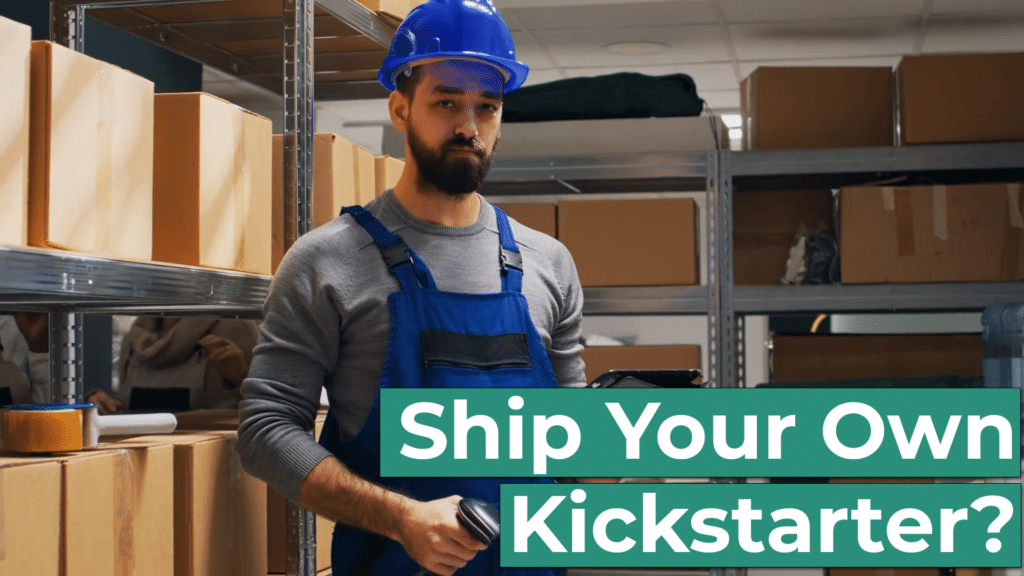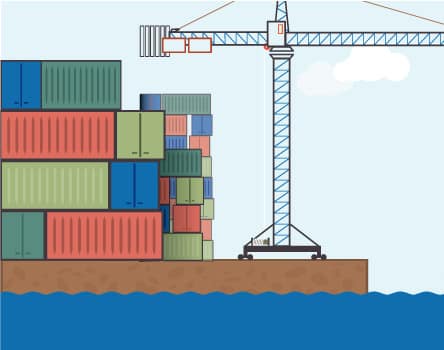If you ship your Kickstarter alone, you’re headed for disaster!
Well, at least that’s what a lot of people – from fulfillment centers to Kickstarter creators – seem to believe. What if I told you that making the decision is actually a little more complicated than that?
That’s right. In this video, we’re going to talk about the ins and outs of handling order fulfillment for your Kickstarter campaign. We’re going to talk about the pros and cons of shipping your own rewards, the pros and cons of hiring help, and when you should make the decision to choose on method over the other for your campaign.
And by the way, if you’re running an eCommerce store, you’ll still find this video handy, even though I’m talking directly to Kickstarter creators today. The same basic principles apply – the main difference is that you’ll need to think about monthly order volume instead of total order volume.
My name is Brandon, here on behalf of Fulfillrite. If you need help shipping your business’s orders, go to fulfillrite.com and request a quote. We’ve shipped for thousands of businesses and we’re happy to help you ship your orders too. The quote doesn’t cost a thing, so if nothing else, you get some good information about pricing. Link in the description.
But enough self-promotion. Let’s talk about shipping on your own.
Shipping On Your Own: Pros
For small Kickstarter campaigns – think under 500 shipments total – or eCommerce stores shipping less than 100 orders per month, shipping on your own is not just tempting. It might actually be the smart move!
Why? The main two reasons are: control and cost. But simple as that sounds, these are nuanced points and the details really matter here, so stick with me.
Taking the reins on shipment gives you an unparalleled level of control. You’ll be able to personally monitor every aspect of your inventory, shipping, and customer service operations. This gives you the opportunity to fix issues yourself as they arise without contacting a customer service line. You’ll never hear heavily compressed hold music as you wait for a customer service representative to connect.
But it’s not just avoiding hassles. You also have the unique opportunity to add personal touches to packaging to delight your customers when it’s time for unboxing. Think about it – bespoke boxes, personal thank you notes, or even small, branded freebies. These little touches can turn an otherwise basic delivery into an unforgettable customer experience, strengthening your relationship with your audience. You can do most of this with a fulfillment company, but it requires you to research the right partner and build a process in advance. You can’t just spontaneously pop a thank you note in the box.
Another compelling argument for going solo? It might actually cost you less.
In our video on how outsourcing fulfillment can save you money, we go over the way that fulfillment charges are calculated. As a recap…
Fulfillment Cost = Account & Storage Fees + ((Postage + Supplies + Pick and Pack Fee) * Packages Shipped)
Did you catch that first part? The account and storage fees that fulfillment centers charge is a way of making sure that clients have a certain amount of order volume before onboarding them. Suffice it to say that onboarding a new client requires a fair amount of work for most fulfillment centers. There’s not a huge difference in terms of business processes between storing five units of inventory and storing five hundred.
I know that sounds weird, but it’s just one of the quirks of this industry. That’s why so many fulfillment centers – including our own – like to see clients have 100 orders per month or at least a few hundred Kickstarter orders before setting up an agreement.
The handful of companies that don’t have these minimums tend to pass the overhead costs on to their clients. The result is that shipping can actually end up costing more than retail prices at your local USPS, UPS, or FedEx. So, in short, that’s a win for shipping on your own.
Again, this is just a general rule. I strongly encourage you to seek out custom quotes for your unique situation.
With that in mind, let’s talk about the downsides of shipping on your own.
Shipping On Your Own: Cons
Shipping on your own has three basic issues: time commitment, scalability, and cost.
Yes, cost shows up again! I’ll get to that in a second.
First off, let’s talk about time. Fulfilling orders, handling returns, and managing inventory can be a 24/7 job. And while there’s a certain satisfaction in being hands-on with these processes, they can quickly gobble up your hours. Hours that could be redirected towards the heart of your business – future product development, sales, marketing. You get the idea.
And let me tell you – I’ve done a couple of small campaigns myself. I shipped about 130 orders back in 2016, and that took me eight hours. That’s just 130 orders. That’s not counting the awkward post office trip where I dropped off 100 packages at a time.
That hints at the heart of the second issue: scalability. If it’s hard to ship 130 orders, imagine how much harder it will be to ship 1,000. Or 5,000. Or 25,000. If your campaign or store really takes off, you’re going to have a very tough time shipping on your own. Where are you going to find the time? Will you even have enough space to store your inventory? You’re lucky to get a 5×10 storage unit for under $100 per month these days.
Then there’s cost again. I covered this at length in our other video, but the short version is this: fulfillment centers pay so much less on postage and supply rates than retail customers. Part of the savings gets passed on to you. This isn’t enough to offset costs at low order volume, but it’s huge when you’re shipping a lot of orders.
So now let’s talk about the opposite approach to shipping: hiring help.
Hiring A Fulfillment Center: Pros
The main pros of hiring a fulfillment center are scalability, cost, and expertise.
Now I touched on those first two earlier, so I’ll just quickly summarize them here.
Shipping more than a few hundred orders on your own or with a small team is very hard. For a fulfillment center, it’s nothing. Huge spike in demand? No big deal. Need to ship out 1,000 orders today? Business as usual. Need to mix and match different items and make sure the orders don’t get screwed up? Easy.
Fulfillment centers do nothing but ship all day long. The problems that can derail your business are business as usual for them. So scalability is not an issue unless you’re making millions.
Then there’s cost. As your order volume goes up, the amount you pay on account and storage fees becomes increasingly small relative to the amount you pay overall. Discounts on postage are often enough to offset the additional cost of labor. In the end, you usually end up at least breaking even, relative to shipping in house, and often saving some money.
Then there’s the matter of expertise. When you entrust your logistical needs to a fulfillment center, you’re partnering with experts, true maestros in their field. These centers specialize in storage, packing, and shipping. Their systems and technologies are streamlined, optimized, and capable of handling high order volumes with precision and speed.
Plus, in addition to being highly competent at the basic things you need on a daily basis, when you start running into big questions regarding subjects like freight, customs, and inventory management, your fulfillment center is likely to either be able to help you or refer you to someone you can. This is so much better than trying to figure out the answers by Googling them, reading Reddit, asking ChatGPT, or relying on the advice of that one guy you know who made millions on dropshipping.
The result? You get peace of mind knowing that your products are being handled expertly.
Of course, working with a fulfillment center isn’t all sunshine and rainbows. There are downsides too. Let’s get into that.
Hiring A Fulfillment Center: Cons
I’ve already talked about how fulfillment centers usually don’t make financial sense until you’re shipping at least a few hundred Kickstarter orders or 100 orders per month for eCommerce. So I’m not going to belabor that point.
Earlier, I said one of the great things about shipping on your own is the fact that you have complete control. That means when you outsource fulfillment to a third party, you don’t have complete control.
Now, if you pick the right partner, this doesn’t matter. You give up control for freedom, and that’s an OK trade-off. But there’s a risk of hiring a bad fulfillment partner, and that is – by far – the biggest risk of hiring a fulfillment center.
Bad fulfillment centers can cause all kinds of problems, such as:
- Late shipments.
- Inaccurate shipments. (Wrong items or wrong address.)
- Surprise fees.
And most of these issues are symptoms of larger process issues behind the scenes. The only really consistent signs that you can look out for to reduce your odds of pairing with a partner that causes these issues are poor communication and bad reviews.
On the flip side, good fulfillment centers have a few qualities in common:
- They have expertise in your niche.
- They have a proven track record of satisfied customers and can prove it with case studies and objective reviews.
- They are great communicators.
One day – not too in the future – we’ll make a video on how to pick the right fulfillment center. For now, though, make sure that you do some heavy research before you sign any papers. You really, really, really don’t want to get tied to a low-quality fulfillment partner, because it can make your backers or customers very cross with you.
The upshot of all this? Pick a bad fulfillment center, and you’ll regret it. Pick the right one, and it can really set your business on a path for sustainable growth!
Now that we’ve walked through the pros and cons of both handling shipping in-house and partnering with a fulfillment center, we’re going to talk about how to make the right choice for you.
Making The Right Choice For You
No matter where you are in your business, it’s a good idea to request fulfillment quotes just so you can have them handy for the future if nothing else. But in lieu of specific quotes, here are three basic rules of thumb you can use to choose whether you need to ship on your own or hire help.
- Consider your order volume. Do you have over 500 orders to ship all at once or at least 100 orders per month on a regular basis? You’re a good candidate for outsourcing fulfillment. Otherwise, you probably are better off shipping on your own.
- Consider your time and resources. Are you spending a lot of time and money shipping? If so, consider outsourcing because you can reclaim that time and some of that money to spend on other aspects of your business that are more likely to lead to growth.
- Consider your growth trajectory. Is your business on track to expand or are sales likely to decrease in the coming years and months? If the former is the case, it might be smart to get a head start and hire some help. Otherwise, you’re probably better off not getting into a fulfillment agreement right now.
There’s no one-size-fits-all answer, so it is going to be a judgment call on your end. But hopefully, these three rules of thumb, along with any quotes you receive, will help you confidently make the right decision for your unique situation.
Whether you choose to manage your shipping or team up with a fulfillment center like Fulfillrite, know that your decision is a major step towards streamlining your operations and propelling your business to new heights.
If you need help shipping your business’s orders, go to fulfillrite.com and request a quote. We’ve shipped for thousands of businesses and we’re happy to help you ship your orders too. The quote doesn’t cost a thing, so if nothing else, you get some good information about pricing. Link in the description.
If you enjoyed this video, please take a moment to like and subscribe. Don’t forget to slap some postage on that bell so we can express ship new videos to you as soon as they drop. And last but not least, if you have any questions, leave a comment below. I will personally answer as many as I can.
Thanks for watching!
You’ve done everything by the book. Your Kickstarter campaign is almost ready to launch.
You made a great product. Built an audience. Set up a campaign page.
But how do you ship it?
We put this checklist together to help you get started. It's free.





